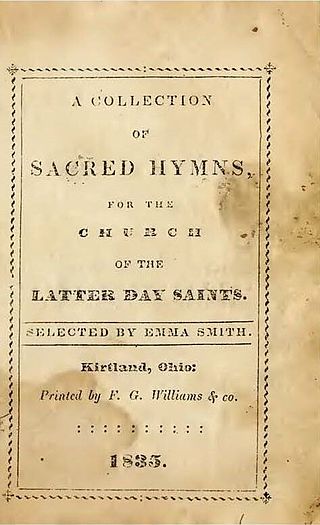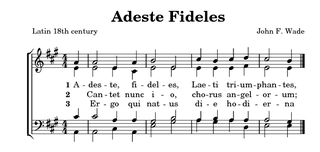The Apostles' Creed, sometimes titled the Apostolic Creed or the Symbol of the Apostles, is a Christian creed or "symbol of faith".

A hymnal or hymnary is a collection of hymns, usually in the form of a book, called a hymnbook. They are used in congregational singing. A hymnal may contain only hymn texts ; written melodies are extra, and more recently harmony parts have also been provided.

"Love Divine, All Loves Excelling" is a Christian hymn by Charles Wesley on Christian perfection. Judging by general repute, it is among Wesley's finest. Judging by its distribution, it is also among his most successful.

Christian music is music that has been written to express either personal or a communal belief regarding Christian life and faith. Common themes of Christian music include praise, worship, penitence and lament, and its forms vary widely around the world. Church music, hymnals, gospel and worship music are a part of Christian media and also include contemporary Christian music which itself supports numerous Christian styles of music, including hip hop, rock, contemporary worship and urban contemporary gospel.
The Methodist Church was the official name adopted by the Methodist denomination formed in the United States by the reunion on May 10, 1939, of the northern and southern factions of the Methodist Episcopal Church along with the earlier separated Methodist Protestant Church of 1828.

A Collection of Sacred Hymns, for the Church of the Latter Day Saints. was the first hymnal of the Latter Day Saint movement. It was published in 1835 by the Church of the Latter Day Saints.

"Christ the Lord Is Risen Today" is a Christian hymn associated with Easter. Most of the stanzas were written by Charles Wesley, and the hymn appeared under the title "Hymn for Easter Day" in Hymns and Sacred Poems by Charles and John Wesley in 1739. The hymn eventually became well known for the "Alleluia" sung as a melisma after each line, which was added by an unknown author, probably to fit the commonly used hymn tune, "Easter Hymn". It remains a traditional processional hymn on Easter Sunday.

The Lutheran Book of Worship (LBW) is a worship book and hymnal published in 1978 and was authorized for use by several Lutheran denominations in North America, including predecessors of the Evangelical Lutheran Church in America and Evangelical Lutheran Church in Canada. The Lutheran Church—Missouri Synod was initially involved in the hymnal's development but officially withdrew.
Kingdom songs are the hymns sung by Jehovah's Witnesses at their religious meetings. Since 1879, the Watch Tower Society has published hymnal lyrics; by the 1920s they had published hundreds of adapted and original songs, and by the 1930s they referred to these as "Kingdom songs" in reference to God's Kingdom.
The New Century Hymnal is a comprehensive hymnal and worship book published in 1995 for the United Church of Christ. The hymnal contains a wide-variety of traditional Christian hymns and worship songs, many contemporary hymns and songs, and a substantial selection of "world music" selections origin, a full lectionary-based Psalter, service music selections, and a selection of liturgies from the UCC Book of Worship (1986). Generally speaking, the hymnal is theologically within the mainline Protestant tradition, with a slant toward liturgical forms.

The Lutheran Hymnal (TLH) is one of the official hymnals of the Lutheran Church–Missouri Synod (LCMS). Published in 1941 by Concordia Publishing House in St. Louis, Missouri, it was the denomination's second official English-language hymnal, succeeding the 1912 Evangelical Lutheran Hymn-Book. The 1969 Worship Supplement contains additional hymns and service music.

Hymns Ancient and Modern is a hymnal in common use within the Church of England, a result of the efforts of the Oxford Movement. The hymnal was first published in 1861. The organization publishing it has now been formed into a charitable trust, Hymns Ancient and Modern Ltd, and as of 2022 it publishes a wide range of hymnals as well as other theological and religious books and magazines, under imprints such as the Canterbury Press and SCM Press.

A hymn tune is the melody of a musical composition to which a hymn text is sung. Musically speaking, a hymn is generally understood to have four-part harmony, a fast harmonic rhythm, with or without refrain or chorus.

The Service Book and Hymnal (SBH) was used by most of the Lutheran church bodies in the United States that today compose the Evangelical Lutheran Church in America (ELCA) prior to the publishing of the Lutheran Book of Worship (LBW) of 1978. In ELCA circles, historically, the Service Book and Hymnal has been called the "red book" while the Lutheran Book of Worship has been called the "green book." The newest ELCA hymnal, Evangelical Lutheran Worship (ELW) is also red in color, and has apparently been dubbed "the cranberry book".
The Lutheran Hymnal with Supplement is the second official hymnal of the Lutheran Church of Australia, first published in its present form in 1989.
The Book of Hymns was the official hymnal of The Methodist Church, later the United Methodist Church, in the United States, until it was replaced in 1989 by The United Methodist Hymnal. Published in 1966 by The Methodist Publishing House, it replaced The Methodist Hymnal of 1935 as the official hymnal of the church.
Mga Awit sa Pagsamba is an interdenominational Evangelical Protestant hymnal published by the National Council of Churches in the Philippines. It was first published in December 1959, and has had eight editions by 2007. The hymnal contains hymns translated into Tagalog which are mainly used by the different Evangelical Churches in the Philippines.

Lutheran Worship (LW) is one of the official hymnals of The Lutheran Church–Missouri Synod (LCMS). Published in 1982 by Concordia Publishing House in St. Louis, Missouri, it is the denomination's third English-language hymnal and was intended to replace The Lutheran Hymnal (TLH). Additional hymns and service music are contained in the companion, Hymnal Supplement 98.

"Lift High the Cross" is a 19th century English Christian hymn. It was written in 1887 by George Kitchin and revised in 1916 by Michael R. Newbolt.











